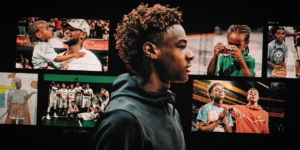Humans may be the masters of rapid-fire banter, but chimpanzees seem to have their own rapid-fire back-and-forth, albeit in the form of hand signals.
Researchers analyzed thousands of gestures made by wild chimpanzees in East Africa and found striking similarities to the turn-taking seen in human conversations, particularly how quickly the apes respond to each other.
The work suggests that humans and apes share fundamental features of communication that either date back to their ancient ancestors or that evolved in parallel in the species because of the advantages the behavior brought.
“Human conversations follow very strict rules of turns that are consistent across cultures and languages,” said Dr Gal Badihi, an animal behavior expert at the University of St Andrews. “We began to wonder whether chimpanzee communication is governed by its own rules, or whether the rules are similar to human conversation.”
Chimpanzees have a rich repertoire of hand gestures, many of which amount to simple requests such as “stop it”, “follow me” or “take care of me”. To learn more about the rules surrounding its use, the researchers studied more than 8,500 gestures recorded from 252 wild chimpanzees in five wild communities in East Africa.
Most of the interactions were brief. In one, recorded at Budongo Conservation Field Station in Uganda, a chimpanzee named Monica reached out to another, named Ursus, after a physical exchange, prompting Ursus to respond with a reassuring tap.
But in other cases, chimpanzees traded up to seven gestures in a row. In these exchanges, the monkeys typically took 120 milliseconds to respond to each other, similar to the average human conversational response time of 200 milliseconds.
“Chimpanzees use gestures in almost every aspect of their lives,” Badihi said. As well as reconciling after a fight, she saw chimpanzees use gestures to avoid confrontation, to greet each other with a hug or kiss, to ask to share food and to indicate that they wanted to travel together or want to go their own way. Grooming sessions were when most gestures occurred.
“Some groups use a big, loud, scratching gesture and then start grooming together. In the middle of the grooming interactions, they can signal to each other to change positions or to start grooming in a new location,” she said.
to newsletter promotion
Write in Current Biology, the researchers describe how the timing between exchanges barely varied between chimpanzees of different ages, but there were some variations between different communities, similar to the subtle cultural differences seen in humans. For example, gestures were exchanged more slowly in the Sonso chimpanzee community in Uganda. “In humans, it’s the Danes that respond more slowly,” said Dr Catherine Hobaiter, a senior author of the study.
Since humans and chimpanzees are both great apes, rapid communication may be a product of our shared evolutionary heritage. Alternatively, rapid turn-taking may be a broader feature of social communication, and exists in other species such as whales, dolphins, bats and hyenas, the researchers add.




